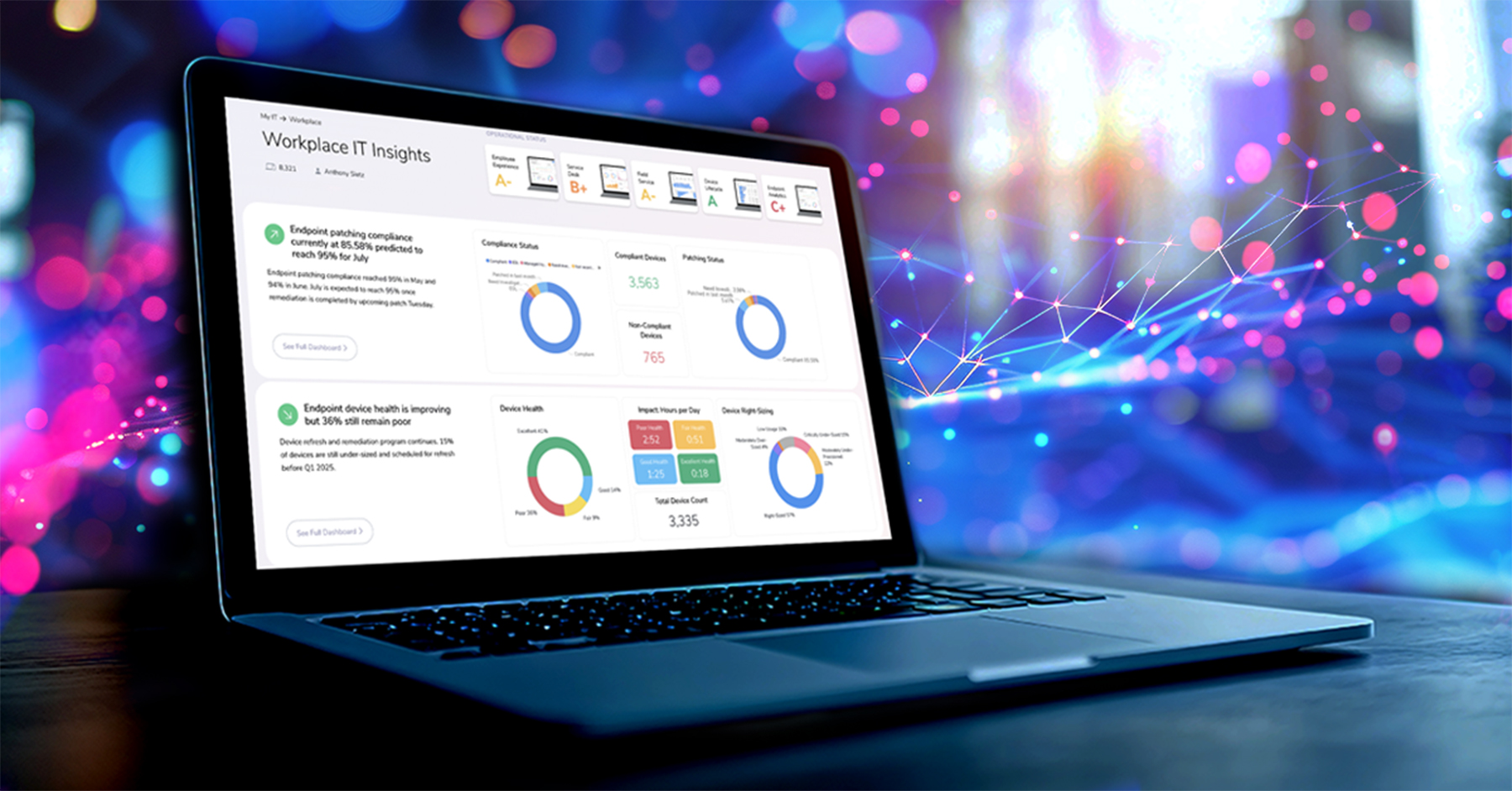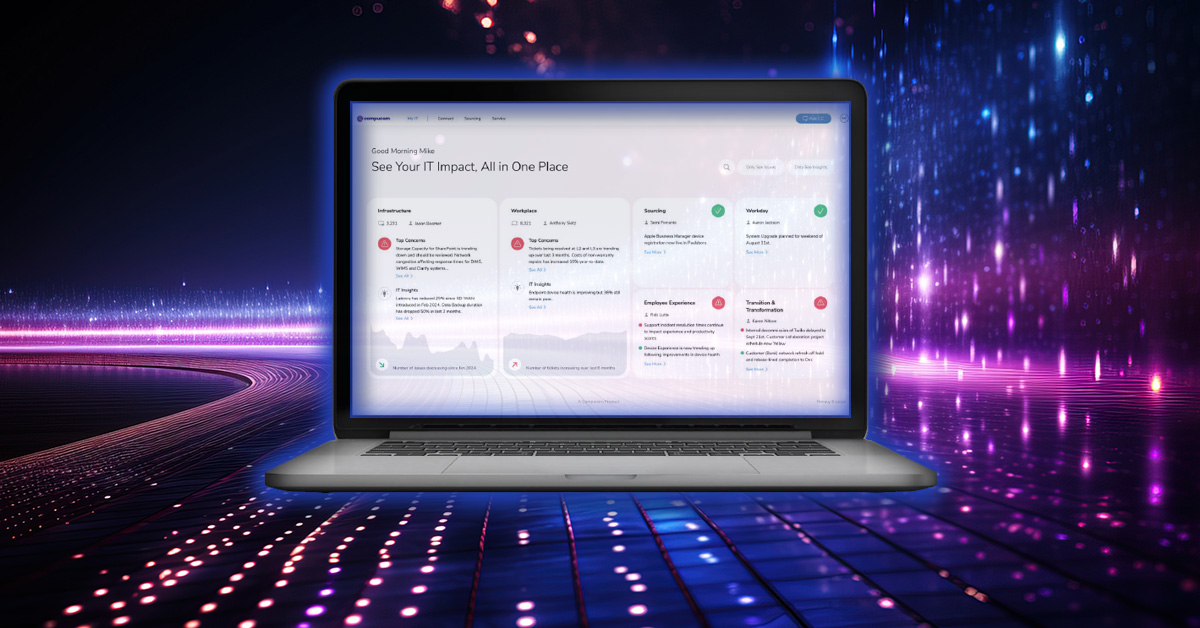- Managed Infrastructure and Cloud Services
- Advanced Technology


Greg Druffel • Managing Solution Architect
Short for Artificial Intelligence for IT Operations, AIOps uses artificial intelligence (AI) and machine learning (ML) to automate and optimize IT processes. And it’s a popular buzzword lately. But, to go beyond the buzzword, cut through the hype, and realize the benefits, AIOps components must be properly integrated with your IT systems.
When done right, AIOps equips your IT talent with powerful tools, freeing them from tedious tasks and allowing them to focus on more valuable, interesting work like cost and risk reduction, ultimately enhancing user experience.
Early AIOps Adoption and Expertise
Gartner coined the term AIOps in 2017. But even before then, Compucom’s delivery teams were investigating ways to help customers cope with the increasing complexity and scale of IT infrastructure combined with the exploding volume of real-time data. As an early adopter of AIOps capabilities, we recognized the urgent need to help our customers better handle their IT operations.
Since they were initially introduced, AIOps tools have matured, becoming more scalable. Through experience, we’ve refined a set of combined tools that can readily integrate our customers’ existing capabilities and customize them to suit their needs and preferences.
To date, we have retail, finance, and healthcare customers that are benefiting from our AIOps expertise. We provide AIOps as part of our Infrastructure Management and Cloud Technology services, and we can support on-premises, cloud, and hybrid environments.
Our AIOps Approach
Compucom’s approach integrates toolsets to handle five AIOps components.
- The Event Management component monitors and manages network, server, storage, application, and IoT data, passing events to the Situational Awareness component.
- The Situational Awareness component correlates events to determine an “incident,” reducing event noise by 98%. The incident is enriched with relevant data to help understand system and business impact in virtual situation rooms that enable collaboration across multiple domains. Algorithms are applied to determine the root cause, learning from previous results and from manual training by the operators.
- The Engage component (IT Service Management or ITSM) manages and records all actions and results from the Situational Awareness and Orchestration Services components. This dramatically improves record and ticket quality, allowing for much more effective Problem Management.
- The Orchestration Services component is instructed by the Situational Awareness component when additional information or action from an endpoint or service is needed. It enables operators to design workflows for diagnosis and remediation, which may include steps asking for human input.
- The Execution Services component directly interacts with the endpoint devices. It executes the commands from the Orchestration Services component and returns the results.
Monitor the Right Sources. Use the Right Tools.
Sophisticated AIOps monitors and ingests data from three layers. Events from these layers can then be correlated to create context and a better understanding of inefficiencies or bottlenecks:
- Hybrid IT Infrastructure: Sources such as compute, network, storage, IoT, logs, and databases as well as events from other Managed Services Providers (MSPs)
- Applications: These include all in-scope business applications hosted within the Hybrid IT Infrastructure.
- Business Transactions: This includes monitoring transactions within the environment, like real-time order volume.
As we put together our version of AIOps, we prioritized the following:
- “Plug and Play” Flexibility: Our flexible interface enables us to easily integrate Compucom and customer tools for various application and infrastructure support requirements — such as monitoring tools, ticketing systems, and incident management systems — switching them out as needs evolve.
- Better Visibility into Applications and Infrastructure: Your organization’s topology provides context for AIOps, and visualizations and dashboards show the big picture of your applications and infrastructure.
- Enhanced Diagnosis and Incident Remediation Capabilities: Incident diagnosis is enhanced through advanced intelligent event aggregation, filtering, correlation, and machine learning. Remediations are optimized with artificial intelligence and business process automation.
- A Minimal Footprint Within Your Managed Environment: The AIOps platform and associated execution engine have a small footprint to minimize the burden on your computing environment.
Effective AIOps Delivers Serious Advantages
Through anomaly detection, event correlation, and enhanced root cause analysis, Compucom’s AIOps equips IT teams to:
- Improve root cause analysis across IT system silos.
- Reduce network congestion.
- Remedy the increased the average response time for an application.
- Cut down the overwhelming volume of alarms.
- Identify issues during change management processes.
- Lower Mean Time to Detect (MTTD) and Mean Time to Remediate (MTTR).
- Dramatically reduce ticket counts and improve ticket quality.
Get a Handle on Your IT Operations
So, is AIOps overhyped? Should system and network administrators start quaking in their Skechers if their boss mentions AIOps because robots are coming to steal their jobs? Definitely not.
With AIOps spending expected to reach $40 billion by 2026, many companies are jumping on board the AIOps train. Ensuring you reach your goals rather than just paying for hype is essential. Going with an experienced provider like Compucom allows your IT talent to reap the benefits of truly effective AIOps.
Our next blog will look at real-life AIOps success stories, showing examples of the benefits to IT operations you can expect from a well-designed implementation.
In this series:
RecenT

9 Ways Strategic IT Staffing Empowers Organizations

Case Studies: Asset Intelligence and Endpoint Compliance Made Easy

AI and the Enterprise: The Future of IT Management

Exploring the Opportunities and Obstacles of AI in the Enterprise

One Dashboard to Rule Them All: Strategic IT Excellence with Full Lifecycle Observability

Transforming IT Operations with Full Lifecycle Observability: How Compucom’s FLO Framework Redefines Data-Driven Efficiency
TOPICS
AIOps: Going Beyond the Buzzword
- Managed Infrastructure and Cloud Services
- Advanced Technology

Greg Druffel • Managing Solution Architect
Short for Artificial Intelligence for IT Operations, AIOps uses artificial intelligence (AI) and machine learning (ML) to automate and optimize IT processes. And it’s a popular buzzword lately. But, to go beyond the buzzword, cut through the hype, and realize the benefits, AIOps components must be properly integrated with your IT systems.
When done right, AIOps equips your IT talent with powerful tools, freeing them from tedious tasks and allowing them to focus on more valuable, interesting work like cost and risk reduction, ultimately enhancing user experience.
Early AIOps Adoption and Expertise
Gartner coined the term AIOps in 2017. But even before then, Compucom’s delivery teams were investigating ways to help customers cope with the increasing complexity and scale of IT infrastructure combined with the exploding volume of real-time data. As an early adopter of AIOps capabilities, we recognized the urgent need to help our customers better handle their IT operations.
Since they were initially introduced, AIOps tools have matured, becoming more scalable. Through experience, we’ve refined a set of combined tools that can readily integrate our customers’ existing capabilities and customize them to suit their needs and preferences.
To date, we have retail, finance, and healthcare customers that are benefiting from our AIOps expertise. We provide AIOps as part of our Infrastructure Management and Cloud Technology services, and we can support on-premises, cloud, and hybrid environments.
Our AIOps Approach
Compucom’s approach integrates toolsets to handle five AIOps components.
- The Event Management component monitors and manages network, server, storage, application, and IoT data, passing events to the Situational Awareness component.
- The Situational Awareness component correlates events to determine an “incident,” reducing event noise by 98%. The incident is enriched with relevant data to help understand system and business impact in virtual situation rooms that enable collaboration across multiple domains. Algorithms are applied to determine the root cause, learning from previous results and from manual training by the operators.
- The Engage component (IT Service Management or ITSM) manages and records all actions and results from the Situational Awareness and Orchestration Services components. This dramatically improves record and ticket quality, allowing for much more effective Problem Management.
- The Orchestration Services component is instructed by the Situational Awareness component when additional information or action from an endpoint or service is needed. It enables operators to design workflows for diagnosis and remediation, which may include steps asking for human input.
- The Execution Services component directly interacts with the endpoint devices. It executes the commands from the Orchestration Services component and returns the results.
Monitor the Right Sources. Use the Right Tools.
Sophisticated AIOps monitors and ingests data from three layers. Events from these layers can then be correlated to create context and a better understanding of inefficiencies or bottlenecks:
- Hybrid IT Infrastructure: Sources such as compute, network, storage, IoT, logs, and databases as well as events from other Managed Services Providers (MSPs)
- Applications: These include all in-scope business applications hosted within the Hybrid IT Infrastructure.
- Business Transactions: This includes monitoring transactions within the environment, like real-time order volume.
As we put together our version of AIOps, we prioritized the following:
- “Plug and Play” Flexibility: Our flexible interface enables us to easily integrate Compucom and customer tools for various application and infrastructure support requirements — such as monitoring tools, ticketing systems, and incident management systems — switching them out as needs evolve.
- Better Visibility into Applications and Infrastructure: Your organization’s topology provides context for AIOps, and visualizations and dashboards show the big picture of your applications and infrastructure.
- Enhanced Diagnosis and Incident Remediation Capabilities: Incident diagnosis is enhanced through advanced intelligent event aggregation, filtering, correlation, and machine learning. Remediations are optimized with artificial intelligence and business process automation.
- A Minimal Footprint Within Your Managed Environment: The AIOps platform and associated execution engine have a small footprint to minimize the burden on your computing environment.
Effective AIOps Delivers Serious Advantages
Through anomaly detection, event correlation, and enhanced root cause analysis, Compucom’s AIOps equips IT teams to:
- Improve root cause analysis across IT system silos.
- Reduce network congestion.
- Remedy the increased the average response time for an application.
- Cut down the overwhelming volume of alarms.
- Identify issues during change management processes.
- Lower Mean Time to Detect (MTTD) and Mean Time to Remediate (MTTR).
- Dramatically reduce ticket counts and improve ticket quality.
Get a Handle on Your IT Operations
So, is AIOps overhyped? Should system and network administrators start quaking in their Skechers if their boss mentions AIOps because robots are coming to steal their jobs? Definitely not.
With AIOps spending expected to reach $40 billion by 2026, many companies are jumping on board the AIOps train. Ensuring you reach your goals rather than just paying for hype is essential. Going with an experienced provider like Compucom allows your IT talent to reap the benefits of truly effective AIOps.
Our next blog will look at real-life AIOps success stories, showing examples of the benefits to IT operations you can expect from a well-designed implementation.
In this series:
Recent Blogs

9 Ways Strategic IT Staffing Empowers Organizations

Case Studies: Asset Intelligence and Endpoint Compliance Made Easy

AI and the Enterprise: The Future of IT Management

Exploring the Opportunities and Obstacles of AI in the Enterprise

One Dashboard to Rule Them All: Strategic IT Excellence with Full Lifecycle Observability




